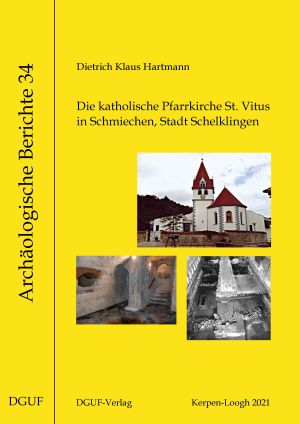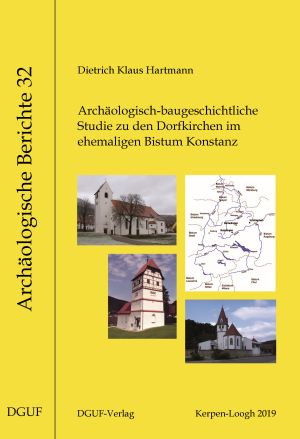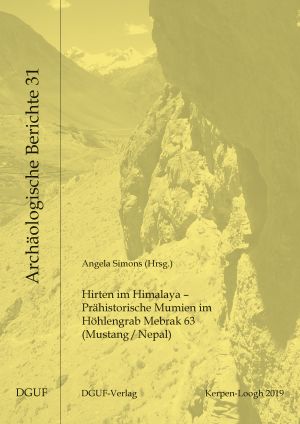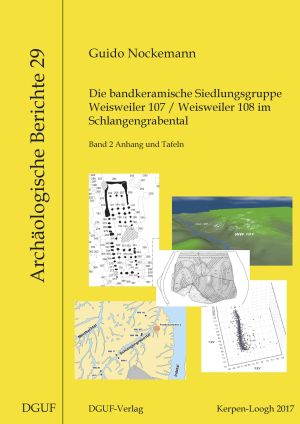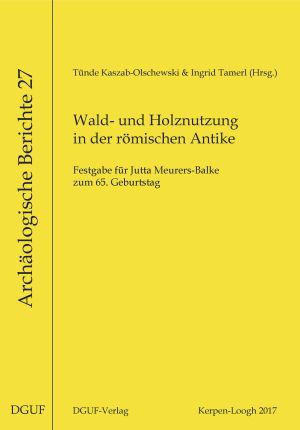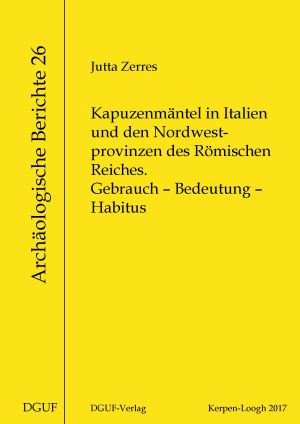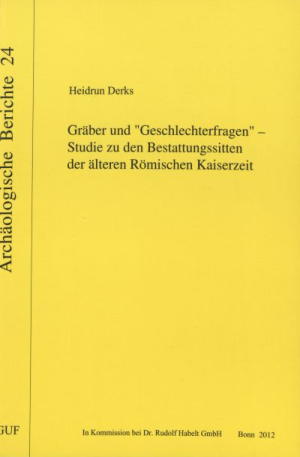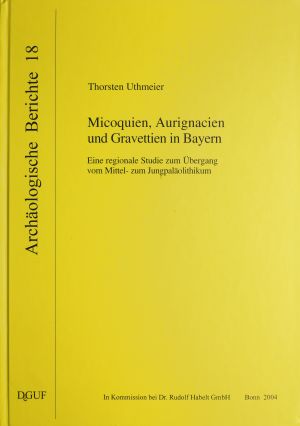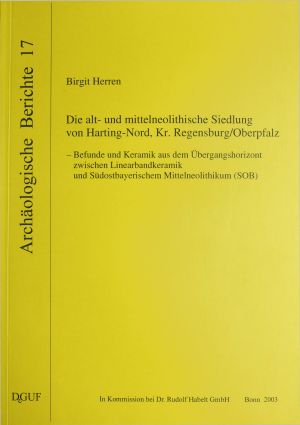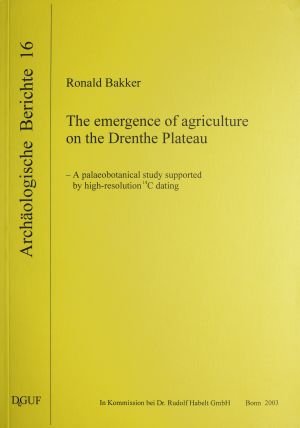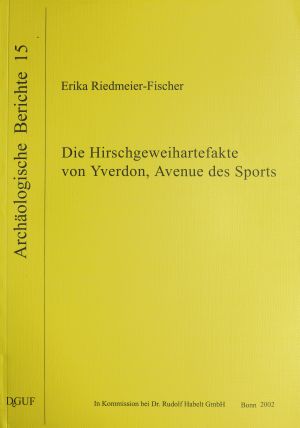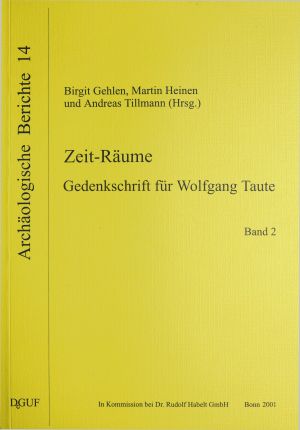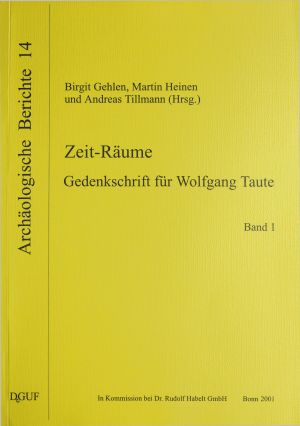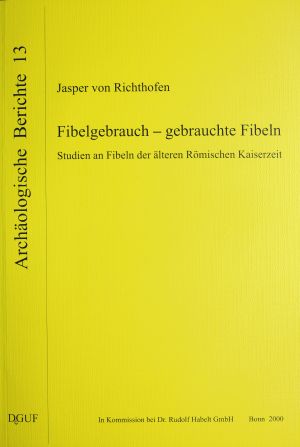Archäologische Berichte
Die „Archäologischen Berichte“ (Arch. Ber.) sind die Monografien der Deutschen Gesellschaft für Ur- und Frühgeschichte e.V. (DGUF). Sie erscheinen seit 1987 mit etwa einem Band pro Jahr. Ziel der DGUF bei der Gründung der Reihe war es, den Autoren eine Möglichkeit zu bieten, mit hoher Reichweite und wissenschaftsüblicher Qualitätssicherung preiswert und schnell publizieren zu können. Um dieses Ziel noch wirksamer erreichen zu können, erscheinen die Monografien seit Band 25 (2014) hybrid: in einer Druckausgabe und – in Kooperation mit der Universitätsbibliothek Heidelberg – zusätzlich online im Open Access. Wie die Zeitschrift der DGUF, die „Archäologischen Informationen“ nehmen auch die Monografien seit Band 25 bei Bedarf ergänzende Materialien und Open Data auf.
In einigen Bänden der Reihe wurden Arbeiten publiziert, die in der DGUF selbst entstanden sind, wie etwa die zweibändige Gedenkschrift für Wolfgang Taute (Arch. Ber. 14, 2001) oder die Literaturempfehlungen des DGUF-Arbeitskreises "Archäologie in Schule und Bildung" (Arch. Ber. 21, 2006). Die überwiegende Mehrheit der Bände entsteht jedoch aus guten Examensarbeiten und Dissertationen, die wir hier – kostengünstig für Autoren wie Leser – zeitnah zum Druck bringen. Die Werke erscheinen mit weltweiter Reichweite, gedruckt und im Open Access, samt Verlag und ISBN-Nummer in einer etablierten Reihe: Ein erheblicher Mehrwert gegenüber einer Publikation in Eigenregie, für Autoren wie für Leser.
Die Bände 1 bis 24 der Reihe wurden im Offset-Druck hergestellt, ab Band 25 erfolgt der Druck der Bücher im Print-on-Demand-Verfahren. Die noch als gedrucktes Exemplar lieferbaren Bände sind einschließlich der Preise auf der Website der DGUF ersichtlich und können bei der DGUF bestellt werden: verlag@dguf.de

Editors
Priv.-Doz. Dr. Frank Siegmund
Dr. Werner Schön
Diane Scherzler M.A.
Dr. Birgit Gehlen
Internet: Redaktionswebsite
Published so far
Eine Siedlungskammer der Ältesten Linearbandkeramik im Nördlinger Ries – Die Sammlung Krippner
The Nördlinger Ries was already densely populated at the beginning of the Neolithic period (c. 5400 cal BC), with 16 documented archaeological sites. In addition, the Enkingen site is one of the oldest Linear Pottery sites outside its area of origin in Transdanubia. In this book, the sites discovered by Franz Krippner, a passionate amateur archaeologist, are presented in detail, their finds scientifically analysed, the social and economic networks examined and a settlement model drawn up. The transition to the subsequent Flomborn stage is then analysed before the book concludes with an outlook on the settlement of Central Europe at the beginning of the Neolithic period.
Additional data: https://doi.org/10.11588/data/FD7DTS
Das Siedlungsmuster des Mittelpaläolithikums in Süddeutschland: Eine GIS-gestützte Archäoprognose für Fundstellen in Bayern und Baden-Württemberg
This study investigates the settlement behaviour and land use of Neanderthals based on the location parameters of Middle Palaeolithic cave and open-air sites in southern Germany. Methodologically, the author works with the "Weighted Layer Approach" (WLA) - a variant of multiple linear regression. The model includes the height above sea level, the slope inclination, the orientation and the distance to the nearest watercourse. These parameters are correlated with geological factors such as the distribution of Pleistocene soils, the presence of a limestone mountain range with caves, and the extent of the Pleistocene ice advances. Wiesner uses the transparently weighted data to calculate an archaeoprediction model, which results in detailed prediction maps for the probability of the presence of previously undiscovered Middle Palaeolithic sites in the area under investigation. The work was awarded the German Study Prize for Archaeology by the DGUF in 2021.
Die katholische Pfarrkirche St. Vitus in Schmiechen, Stadt Schelklingen
The Catholic parish church of St. Vitus in the Schmiechen district, town of Schelklingen (Alb-Donau district), in its current appearance is a mixture of different eras, from Gothic to modern. Archaeological investigations carried out in the course of a redesign and extension in 1990 and 1992 revealed a number of predecessor buildings, the earliest of which can be dated to the 9th century. The first church building, which in turn was erected on a pre-existing cemetery and on foundation remains of unknown date, was followed by several high and late medieval construction phases before the church was greatly expanded in the present by lateral additions. A special feature for a church in a rural area is the small barrel-vaulted crypt built in the 12th century as part of an extension. The finds recorded during the excavation inside the church, especially the pottery, are a valuable addition to the hitherto rather sparse material available for the region in question. Thus, the present investigation is an important building block for the research of the rural church landscape of southeastern Baden-Württemberg.
Die ehemalige katholische Pfarrkirche St. Georg in Burladingen
Even though the former parish church of St. Georg at Burladingen, Germany, nowadays appears as an example of late baroque architecture, archaeological excavations in 1982 showed a number of previous buildings, of which the oldest one dates back to the 8th century. For the first time, the important results of this excavation, showing the typical evolution of a rural parish church in south-western Germany, will be presented within this volume. The initial phase is characterised by a small early medieval church, erected on a preexisting churchyard. Several times rebuilt during the following centuries, the current building is the result of a major reconstruction in 1770. Unusual in the context of church excavations, a rather large number of finds – especially ceramics – was recorded. This major addition to the fairly small corpus of relics in the area is used to extend the knowledge of the material culture in the region. This publication is part of a multi-volume project by the author, of which the first section, an overview of rural churches in the south-eastern area of Baden-Württemberg, was published in 2019.
Archäologisch-baugeschichtliche Studie zu den Dorfkirchen im ehemaligen Bistum Konstanz
The eastern part of the former diocese of Konstanz / Constance represents a mostly rural area, where a large number of historical churches still exists. As some of them originally date back to the early middle ages, many of them were the subject of archaeological excavations during the last decades. This book, using the database of the Landesdenkmalamt Baden-Württemberg, aims at giving a complete overview of this research, most of which remained unpublished till today.
The main focus of this book is an attempt to compare the different forces influencing the early appearance of these churches. Especially the local existence of early-medieval settlements and the possible role of monastic property will be shown. As a result, it is possible to gain a comprehensive overview of the evolution of church architecture within a historical region.
The churches of St. Georg at Burladingen, St. Vitus at Schmiechen and St. Peter and Paul at Nusplingen, which constitute the basis of this work, will be presented in following volumes of this series.
Additional infomations you find here:
https://doi.org/10.11588/data/ENNK5V
Hirten im Himalaya – Prähistorische Mumien im Höhlengrab Mebrak 63 (Mustang/Nepal)
This publication reports the results of the archaeological investigation of the prehistoric burial cave Mebrak 63 in Dzong valley, a high mountain valley in the Nepal Himalayas. 15 authors describe the excavation and present the interpretation of the complex archaeological findings and remains in ten chapters. In the appendix primary data are included: tables, the catalogue and plates of the archaeological finds.
Co-operation between archaeology and anthropology, textile archaeology, archaeo-botany and dendro-archaeology made it possible to reveal to a great extent the meaning of the prehistoric grave chamber and to come close to the people who were entombed in the collective burial cave in the last millennium before the Christian era. The analysis of the findings which, due to their preservation, are so far unique, provides insight into the way of life and the wide spread exchange and trade links of the prehistoric pastoralists.
Die bandkeramische Siedlungsgruppe Weisweiler 107 / Weisweiler 108 im Schlangengrabental: Band 2. Anhang und Tafeln
The Aldenhover plate came into the focus of the Bandkeramik research 40 years ago. Before the digging of soft coal, countless excavations and prospection were and still are being made. This book is about the archaeological findings and evaluation of the Bandkeramik settlement of Weisweiler 107 and Weisweiler 108 in Schlangengrabental on the Aldenhover plate situated in the Rhineland. This publication aims to not only document the bandkeramik legacy but also to accentuate the specialities and characteristics of the settlements Weisweiler 107 and Weisweiler 108. Furthermore this book attempts to clarify the cultural historical position and function of the Rhineland Bandkeramik. In order to do that, the findings are being compared with other settlements. Moreover a chronology of the settlement is complied and its role in different networks e.g. ceramic decorations or trading of flint artefact is analysed. This project closes a gap. For the first time all of the known settlements of the Bandkeramik age of the Schlangengrabental are documented and analysed as one.
Volume Archäologische Berichte 28 presents the analysis and results.
Die bandkeramische Siedlungsgruppe Weisweiler 107 / Weisweiler 108 im Schlangengrabental: Band 1. Dokumentation und Auswertung
The Aldenhover plate came into the focus of the Bandkeramik research 40 years ago. Before the digging of soft coal, countless excavations and prospection were and still are being made. This book is about the archaeological findings and evaluation of the Bandkeramik settlement of Weisweiler 107 and Weisweiler 108 in Schlangengrabental on the Aldenhover plate situated in the Rhineland. This publication aims to not only document the bandkeramik legacy but also to accentuate the specialities and characteristics of the settlements Weisweiler 107 and Weisweiler 108. Furthermore this book attempts to clarify the cultural historical position and function of the Rhineland Bandkeramik. In order to do that, the findings are being compared with other settlements. Moreover a chronology of the settlement is complied and its role in different networks e.g. ceramic decorations or trading of flint artefact is analysed. This project closes a gap. For the first time all of the known settlements of the Bandkeramik age of the Schlangengrabental are documented and analysed as one.
Volume Archäologische Berichte 29 documents the data and the research.
Hooded cloaks in Italy and the northwestern provinces of the Roman Empire: Use - Meaning - Habitus
In Roman times, hooded cloaks were highly valued and widespread garments because of their weather resistance. This study, however, illuminates more than the classical questions of all archaeological studies by typology, chronology, material and distribution. It is focused on a hitherto neglected aspect of this everyday object: its role in social communication. The historical and archaeological source material is analyzed with regard to the following questions: Are there persons or groups of persons whose habitus (in the sense of the French sociologist P. Bourdieu) include hooded cloaks? Which actors can be identified? Do they use special shapes of cloaks for that purpose? In what situations do they wear the garment and what messages do they convey? Where do the meaning assignments used come from? How do the actors deal with them? The areas under investigation are Italy and the north-western provinces of the Roman Empire during the period of the late Republic up to the Late Antiquity.
Zur Keramikchronologie der Römischen Kaiserzeit in Ostwestfalen anhand der Siedlungen von Enger, Hüllhorst und Kirchlengern im Ravensberger Land
The typology established by Rafael von Uslar in the 1930s as well as the typology and chronology concerning Rhine-Weser-Germanic ceramics (1.-3. century a.d.) are both revised thoroughly in this book. Findings that support the typology and chronology are being organized and serialized (correspondence analysis) at the same time. The study is based on the complete template and the nuanced workup and classification of the ceramics from three imperial settlements in East Westphalia – Enger, Hüllhorst and Kirchlengern – as well as the reanalysis of related ceramics from complexes already published that mostly originate from settlements, too. This type of chronology allows for a more precise dating of settlements of the Roman Empire. On the basis of the ceramics the order of houses and adjoining buildings in the three settlements Enger, Hüllhorst and Kirchlengern have been sketched and dated. The settlement history of the three places has been reconstructed as well.
Additional infomations you find here:
Gräber und ‚Geschlechterfragen‘: Studie zu den Bestattungssitten der älteren Römischen Kaiserzeit
Cemetery for males, cemetery for females or “optical” illusion? Male or female? Cultural phenomenon or a fallacy caused by source material? Since the long 19th century these questions go hand in hand with research on graves and graveyards of the early Roman Imperial period between the Elbe and the Oder.
The study at hand summarizes the course of previous discussions and delivers an extensive examination of this controversial issue, that has been debated over for about 150 years, by analyzing over 7.000 single findings from over 300 sites. The study furthermore brings potential interpretations and explanatory models into focus and thus moves beyond the realm of archaeological research.
Comparative analysis of ethnological studies
For the first time a comprehensive comparative evaluation of ethnological studies about the relevance of gender in funeral rites is being presented. The study gives insight on the diversity of arrangements and meanings of gender specific funeral rites and on the “interaction” between life and death expressed by the rites.
Interplay between political, economic and social factors
Reconsidering and linking back to the early Roman Empire it becomes clear that conceptions of cultural “gender” affected funeral rites at that time considerably, but they by no means determined them single-handedly. Despite the sometimes vague and diffuse source material, it can be argued that a complex interplay between political, economic and social factors needs to be considered in order to interpret and explain the regional diversity as well as the historical changes observed concerning rites for grave goods.
At the same time, however, there is some evidence that the gender concept gathered from the funeral rites possibly was influenced by external factors – threats, elite formation, increase in “prosperity” – and was subject to considerable changes in the course of the early Roman Imperial period.
New Perspectives on Querns in Neolithic Societies
Since the time of the first Neolithic societies, humans have processed the corn of the crops into flour by means of querns. Domestication and breeding of animals as well as cultivation and processing of crops constitute the basis of agrarian living. Initially within the past fifteen years, fundamental aspects of plant processing could be clarified. Research on grinding stones and hones contributes to the understanding and knowledge of Neolithic forms of economy and social organisation. Recent more or less regional studies provide new data that enable conclusions on exchange systems of raw materials, of economic basics and on the social and symbolic meaning of grinding stones.
The articles published in this issue result from a conference held in September 2007 at the 13th annual meeting of the European Association of Archaeologists (EAA) in Zadar (Croatia).
The essays show that a global overview of querns contributes significantly to the interpretation of status and function of a settlement site.
Literaturempfehlungen zur Archäologie: Fachliteratur, Sachbücher, Kinder- und Jugendliteratur
With this bibliography the DGUF work group “Archaeology in the Schoolbook” offers a compilation including specialized literature as well as books for children and young adults. It is intended for authors of schoolbooks, teachers, museum pedagogues, students and interested laymen.
The directory with comments by specialist researchers is organized into eras, themes and at times federal states and covers topics concerning the Paleolithic and Middle Ages. It is a well-structured reference book for everybody in search for an easy introduction to the pre- and ancient history of Middle/Central Europe.
Befund Kind: Überlegungen zu archäologischen und anthropologischen Untersuchungen von Kinderbestattungen
Graves are some of the most important sources for research in pre- and ancient history. Only with detailed knowledge of scientific methods as well as of their possibilities and limits, the decision to recover human remains and analyze them for a specific archaeological epistemological interest can be pursued. Especially the utilization of invasive methods requires particular care.
Modifying methods applied for forming a diagnosis on human remains of adults is not sufficient for taking into consideration diagnosed features of (deceased) children – which at the same time may have varying characteristics due to maturity processes – adequately.
Also, certain criteria determine whether written sources can be used as part of an analogical conclusion. These criteria may structurally resemble problems of applicability faced when using anthropological methods.
The present overview on archaeological and anthropological methods for the diagnosis and evaluation of children’s organic remains is intended as a contribution for methodology.
Micoquien, Aurignacien und Gravettien in Bayern: Eine regionale Studie zum Übergang vom Mittel- zum Jungpaläolithikum
Bayern ist ein Schlüsselgebiet in der Diskussion des Übergangs vom Mittel- zum Jungpaläolithikum. Die in den immer eisfreien Korridor zwischen skandinavischem und alpinem Eisschild eingebettete Donauebene verbindet als ein wichtiger eiszeitlicher Wanderungsweg die reichen Fundregionen des späten Mittel- und frühen Jungpaläolithikums in Südwesteuropa einerseits und Mittel- und Osteuropa andererseits. Mit Fundstellen des spätesten Mittelpaläolithikums, des frühesten Aurignaciens und des Gravettiens bietet sich hier die einmalige Gelegenheit, bisherige Erklärungsmodelle für eine der spannendsten Kapitel der Menschheitsgeschichte - der Ausbreitung des modernen Menschen - zu überprüfen.
Die alt- und mittelneolithische Siedlung von Harting-Nord, Kr. Regensburg/Oberpfalz: - Befunde und Keramik aus dem Übergangshorizont zwischen Linearbandkeramik und Südostbayerischem Mittelneolithikum (SOB)
Im Unterschied zu allen bis dato untersuchten Fundplätzen Niederbayerns ist in Harting-Nord der Übergang von Alt- zu Mittelneolithikum erfasst. Im Altneolithikum stehen die Hausgrundrisse und Gefäße noch ganz in linearbandkeramischer Tradition.
Die Untersuchungen von Birgit Herren zeigen, dass sich mit zunehmendem Kontakt zu der in Böhmen und im Elbe-Saale-Gebiet entstandenen Stichbandkeramik entsprechende Kulturelemente auch in Harting-Nord niederschlagen: Der sukzessive, kontinuierliche Wandel von Linearbandkeramik zum älteren Südostbayerischen Mittelneolithikum (kurz SOB I) ist sowohl in den Hauskonstruktionen und den Gefäßformen als auch im Verzierungsstil anschaulich nachzuvollziehen. Die Siedlungsstruktur ändert sich hingegen nicht. Die neolithische Siedlung von Harting-Nord endet vor dem Einsetzen des regionalen Verzierungsstils im SOB II.
The emergence of agriculture on the Drenthe Plateau: A palaeobotanical study supported by high-resolution 14C dating
Sediments from a pingo scar, a relic from the last glaciation, in the province of Drenthe (the Netherlands) are studied for their content of pollen and macroscopic remains. On the basis of nine pollen diagrams, the author reconstructs the vegetation from the Preboreal up till the present. Special attention is given to the beginning of the Neolithic, which marks the beginning of agriculture. A model is developed which describes changes in human-influenced pollen types during the Neolithic in pollen diagrams from Pleistocene areas near the North Sea coast.
The so-called Neolithic Occupation Period (NOP) is divided into three phases, which represent three different types of farming economy. By means of high-resolution 14C dating, the three phases are correlated with archaeological cultures. Phase NOP-1, characterized by small-scale arable farming and livestock foddering with leaves and twigs, is dated to 4050-3450 cal BC, which is in the period of the Swifterbant Culture. This shows that the first farmers on the Drenthe Plateau belonged to the Swifterbant Culture. Phase NOP-2, characterized by more large-scale, grass-based stock keeping, is connected with the Funnel Beaker Culture. Phase NOP-3, in which agriculture was concentrated in smaller areas, is contemporary with the Single Grave and Bell Beaker Cultures.
Die Hirschgeweihartefakte von Yverdon, Avenue des Sports
The present paper examines deer antler artefacts excavated at the Late Neolithic settlement of Yverdon, Avenue des Sports, at Lake Neuchâtel in Western Switzerland. After introdutory chapters on the status of research and production techniques as well as on the evaluation of existing chronologies, the finds are presented and analysed stratigraphically. The antler artefacts from Yverdon, which date mainly to a period between 2.750-2.550 BC, provide the basis for the interpretation of late Neolithic finds from Western Switzerland compared with those of Eastern Switzerland and the Lake Constance region. In the west, there is a considerable influence of the southern French Saône-Rhône-culture, whereas in the east, a strong assimilation to Corded Ware culture is evident - a fact confirming impressively the already existing pottery analyses.





